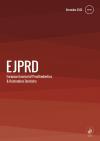European Journal of Prosthodontics and Restorative Dentistry
Impact of Treatment with Unilateral Implant Supported Fixed Partial Prosthesis on the Frequency of Masticatory Side Switches in Patients with Unilateral Posterior Missing Teeth
Abstract
This study aimed to determine the impact of treatment with an implant-supported fixed partial prosthesis (ISFPP) on the frequency of masticatory side switches in patients with unilateral posterior missing teeth. This was a prospective study of 30 patients with unilateral posterior missing teeth treated with one-, two-, or three-unit ISFPPs. Comparison was with 10 healthy individuals with complete natural dentitions. Each participant performed masticatory assays, which involved chewing pieces of silicon inside a latex bag, at baseline and at 3-months’ follow-up. The frequency of masticatory side switches was reported as the masticatory side-switch index: the number of side switches divided by the maximum number of possible switches. Data were analyzed by Kruskal–Wallis,
Mann–Whitney U test, or Wilcoxon test, as appropriate. At baseline, the masticatory side-switch index was lower only in patients with three missing teeth than in controls. At 3 months after treatment, a significant increase in the masticatory side-switch index was only observed in patients treated with three restorative units. Treatment with ISFPPs does not change the masticatory side-switch frequency in patients with unilateral posterior missing teeth, though it could increase it in patients with three missing teeth.
Keywords
Dental Implants
Dentition
Mastication
Authors
Laura Khoury-Ribas, Tatiana Ignatova-Mishutina, Bernat Rovira-Lastra, Raul Ayuso-Montero, Jordi Martinez-Gomis
Articles from this issue
 Free Access
Free Access No Access
No Access Full Access
Full Access


